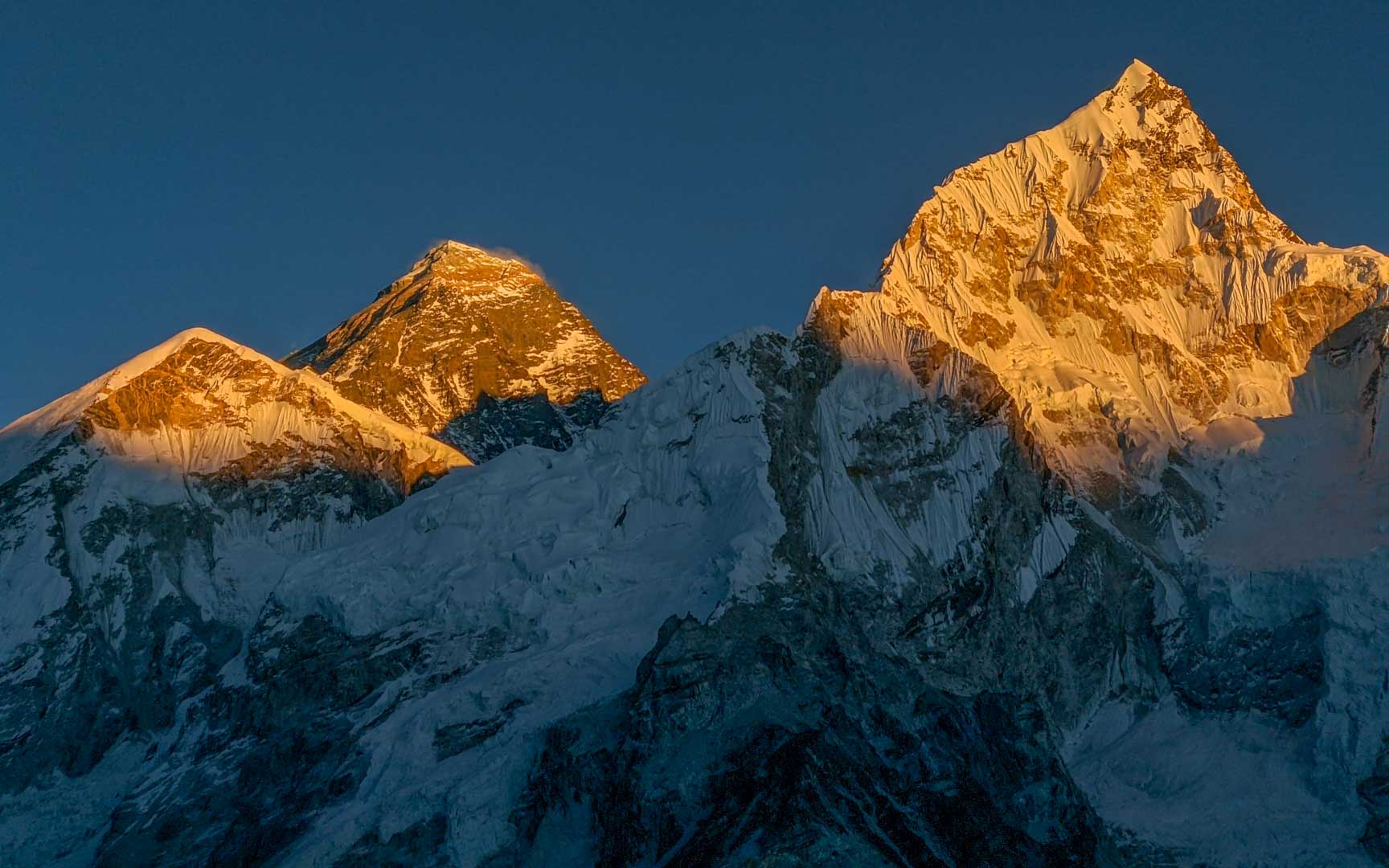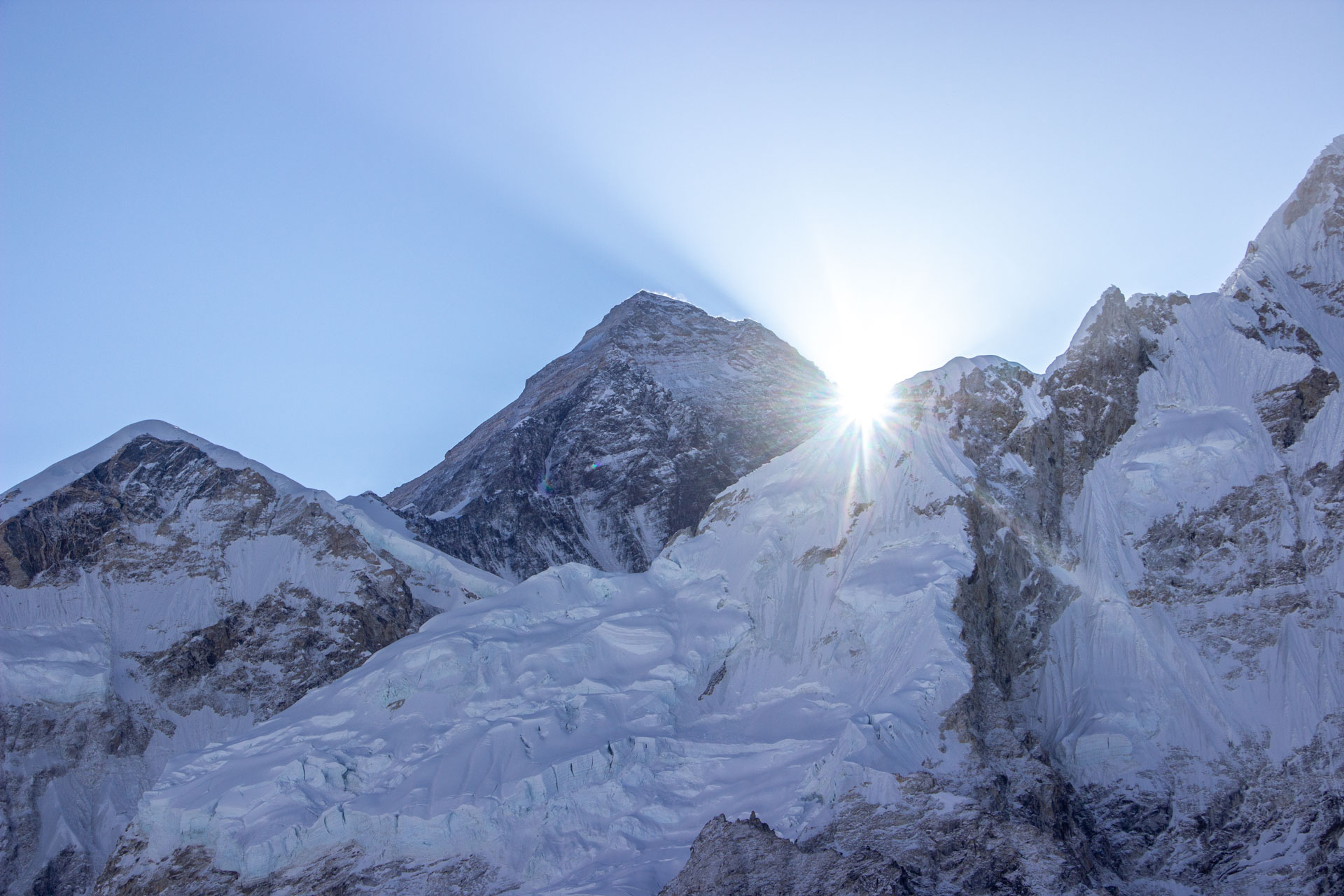
Kala Patthar is the spot for those who wish to see an up-close unobstructed view of Mount Everest. And at 5,643 meters, Kala Patthar is more than just a viewpoint. Given that it is higher than four of the seven summits, a trek to Kala Patthar is a journey that you will cherish for the rest of your life. And if you are planning to go, here is how you can get the best of it.
Quick Facts about Kala Patthar
| Elevation | 5,643 m / 18,373 ft |
| Region | Everest Region, Nepal |
| Difficulty | Moderate to Strenuous |
| Best Season | September to December & March to May |
| Nearest Airport | Lukla |
| How to get there? | 12 Days trek from Lukla or Helicopter Tour from Lukla /Kathmandu |
| Comparable Viewpoints | Gokyo Ri, Renjo La Pass |
Mountains seen from Kala Patthar
The 360-degree mountain view from Kala Patthar is absolutely stunning! Some of the mountains you can see from there are the:
Above 8,000 meters: Everest and Lhotse
Above 7,000 meters: Nuptse, Changtse, Pumori
Above 6,000 meters: Ama Dablam, Chumbu, Thamserku, Kangtega, Taboche & Lobuche.
Kala Patthar is actually one of the few spots from which you can see an unobstructed view of Mount Everest. Because of the topography, the Lhotse wall blocks Everest from most vantage points. For the first few days of EBC Trek, you see a little tip of the peak, and once past 4,000 meters, you stop Everest altogether. It actually comes as a surprise to most people that you cannot see Mount Everest from Everest Base Camp!! Kala Pattar is indeed an extraordinary place in that regard.

As a bonus, you also get to see Khumbu Icefall, Khumbu Glacier, and Everest Base Camp from there.
The Naming of Kala Patthar

The strange thing about Kala Patthar’s name is that it neither comes from the local Sherpa language nor from Nepali. And as you might have guessed, it definitely doesn’t come from English. Surprisingly, Kala Patthar’s name comes from Hindi and literally means Black (Kala) Rock (Patthar). To be fair, it is an apt name as there are quite a few black rocks at the top.
We couldn’t find who named it or when. But we did find that this viewpoint did not have a name till the 1950s. On the other hand, it did have one by 1980. We know this as there is no mention of the viewpoint as Kala Patthar in Tilman’s 1953 book, while Harka Gurung mentions it in the 1980 book Vignettes of Nepal.
What happened between those years? Perhaps a map by the Survey of India or perhaps a movie called Kala Patthar. Your guess is as good as ours.
Everest Base Camp vs. Kala Patthar

While most people go to both, you might have to choose between the two in case of bad weather or some other constraints. Here are some factors you might want to consider. Also, please note that there are no tents at Everest Base Camp outside of the climbing season from March to May. And no, you can’t see Everest from base camp.
| Kala Patthar | Everest Base Camp | |
| Mountain Views | Out of this world, including Everest | So So. Everest not visible. |
| Bragging Right Level | So so. | Donald Trump |
| Time from Gorakshep | 4-5 hours total | 4-5 hours total |
| Distance from Gorakshep | 3.7 km both ways | 8.8 km both ways |
| Altitude | 5,644 meters (+480 m from Gorakshep) | 5,364 meters (+200m from Gorakshep) |
| Difficulty Level | Short but hard climb. | Long but easy walk. |
| Risk | Slipping and falling. | Glacier walk. |
| Experience | A huge sense of achievement at the summit | Amazing experience, but not comparable to the one at Kala Patthar. |
Sunrise vs Sunset View at Kala Patthar

Another very commonly asked question is whether to go to Kala Patthar for sunrise or sunset. In most cases, the answer is sunrise because mornings have the highest chances of being clear.
However, if you have a clear evening at Gorakshep, we insist you make your way up. The surreal pinkish-blue alpenglow is something you never forget for the rest of your life. Check out our homepage to see what we mean, or check out the video below and fast-forward to the 35 minutes mark.
| Sunrise at Kala Patthar | Sunset at Kala Patthar | |
| Visibility | Usually better | Hit or miss especially from March-June |
| Wind | Low | High winds esp from Mar-June and Dec-Feb |
| Temperature | Low | Low |
| Lighting | Everest is backlit. | Everest is frontlit. |
| Ambience | Nothing extraordinary. | Out of this world magenta alpenglow. |
| Notes | Start early to catch the sunrise. | Take extra warm clothes and a flashlight. |
Also do check out the monthly weather breakdown we have in this post.
When to go to Kala Patthar?

The prime season to do Kala Patthar and post trek is March to May and September to November. These months combine warm temperature with good visibility and generally stable conditions with minimum precipitation. But regardless, the best season depends a lot on your liking. Just know what you are looking for from your trek, check out this post, and prepare accordingly.
Here are two climate charts for Kala Patthar, one showing visibility and the other showing temperature/precipitation.

Spring
The spring season is from mid-February to the end of May, with March to May holding the hottest time of year with temperatures up to 30°C. The rhododendrons and other spring flowers bloom. The weather is relatively warm, with good clear views in the early mornings.
Summer
Summers last from June to August and bring a lot of rain to this part of the world. They are characterized by relentless rainfall and a lot of clouds. Think flight cancellations and zero mountain views.
Autumn
The fall season, known as the dry season, is from mid-September to the end of November. You’ll have the highest possibility of clear skies before the snow arrives in late December.

Winter
Winter is from December to February, and it gets cold! The temperature is around -30°C. In the daytime, the minimum temperature would be about -10°C. Still, the views are fantastic, at least till December with minimum cloud and haze.
Environmental Hazards
Also, please note that the wind and sun are essential factors to consider up in the mountains. What might start as a bright and sunny day can quickly change into a miserably cold day if it gets windy and cloudy. Prepare for it with some extra warm clothes and a good wind jacket. Also, remember to protect your skin and eyes from high UV radiation with good sunglasses and sunscreen. Check out this post for more details.
How to get to Kala Patthar?

There are basically two ways to get to Kala Patthar. You either trek there or take a helicopter. While each has its own merits, please note that helicopters can’t land at the summit. This is because of the rocky terrain and the wind factor.
As such, they land at a field just below the summit. That means that while Mount Everest’s view is still stunning, it is not the same as a summit view.
Walk from Lukla

To get to Lukla, you can either take a 25-minute flight from Kathmandu or a 2-day jeep ride and half-day hike via Phaplu. Once at Lukla, you will have to walk for around 8 days to reach Gorakshep, the village that is nearest to Kala Patthar.
From there, it is a steep 2-3 hours climb to the summit.
Helicopter from Lukla/Kathmandu

Suppose you don’t have such a long holiday to see Mt. Everest from Kala Patthar. In that case, you can take a helicopter from Lukla or Kathmandu. And within 1-2 hours you will be there at Kala Patthar in front of a view like the one above.
However, please note that the ground time will usually be limited to 10 minutes, and the helicopter can’t land at the summit of Kala Patthar.
Hazards at Kala Patthar

When you prepare for the mountains, hope for the best, but be ready for the worst. Please note that while we call Kala Patthar a viewpoint, at 5,644 meters, it is higher than the highest peak in Europe. Here are some things you will need to prepare for:
Altitude Illnesses
Avoid altitude illnesses including the life-threatening HACE and HAPE by ascending slowly, drinking enough water, taking enough rest, avoiding alcohol, and using Diamox preventively. Read more about AMS.
Traumatic Injuries
It is a steep climb to the summit of Kala Patthar, and just behind the summit is a vertical drop. Add snow and wind to the slopes, and you know why you need to be careful at Kala Patthar.
Sunburn
Severe sunburn not only looks but must be treated as a second-degree burn. But as we all know, it is easily preventable. Make sure to apply your sunscreen fifteen minutes before exposure twice a day.

Snow Blindness
And the high amount of UV in the Himalayas takes its toll. Hence, sunglasses with good UV protection are necessary. You should put them on even on overcast days to prevent snow blindness.
Hypothermia
As you gain altitude, the mercury will plummet. Add wind and clouds to the mix, and you are talking about ungodly temperatures. We don’t even want to think about heavy snow and an overnight bivouac for now. Please get a good wind jacket, waterproof boots, and a lot of warm clothes.
Khumbu Cough
As you go higher, you will cough that much more, and at times, the coughing can get so violent that it hurts like hell. Bronchial irritation due to the cold, dry air perhaps has something to do with it.
For more information on the Health and Safety Issues while trekking in Nepal, check out this post.








